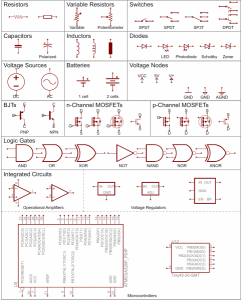Please reply to this post to verify your wordpress blog settings are correctly configured.
Introduction to Physical Computing
60-223 Fall 2017
Please reply to this post to verify your wordpress blog settings are correctly configured.
Due Midnight, Monday, 4 September 2017. Submit your statement as a response to this post. If you can’t submit a response, email me your statement at jtownsen@andrew and let me know you are having problems with the blog.
Work with your partner(s) to write a three or four paragraph artist’s statement about you, what you like, and what you’ve done. Include your experience with electronics projects, art projects, or activities outside your major that reflect who you are as a person.
Golan Levin and Hiroshi Ishii have good summaries of complex, massive careers.
A good guide to writing statements.
Here’s a one-paragraph statement I use on my resume:
“I am a designer, maker, and arts-engineer, with a professional interest in using, designing and evangelizing new tools for creativity. I have more than 20 years’ experience developing projects with DIY technologies and other arts-engineering workflows, including software development, electronics design, computer-aided design, and digital fabrication. For the past eight years, I have directed a small consultancy in Pittsburgh, Functional Prototype, which creates proof-of-concept models, working prototypes, and customized physical interaction devices. My personal and professional projects range from industrial design products and open-source software to art-cars and music performance. I run a clean, well-organized studio; I have a very healthy respect for safety; and I love to empower people by teaching them how to create their own circuits, software, clothing, and costuming accessories.”
jet’s office hours: Fridays, 1-4, IDeATe Lab.
Basics of circuit drawings and making circuits. There’s an excellent reference at Sparkfun. Print out this graphic: and put it on the inside cover of your sketch book:

ASSIGNMENT: We skipped this very important topic in class because of networking issues. Please read our code of conduct. If you are not a CFA student please ask me in class or in person if you have any questions or concerns about this policy.
READING/WATCHING ASSIGNMENTS:
Review the class syllabus including rules for attendance and grading.
We will add students to the blog on Thursday so you can ask questions or comment on notes or projects.
From simple to complex:
Where/why does physical computing matter?
Physical computing has support in places like the Exploratorium.
Art and design + engineering and robotics ==> physical computing projects.
Golan’s Double-Taker
Daniel Rozin’s interactive mirrors.
Haptics class demo of a new product.
We will go over the artist’s statement assignment in detail on Thursday.
Classroom: Hunt Library, A10
Instructor: J. Eric Townsend aka “jet”, jtownsen@andrew
T/A: Sydney Ayers, sayers@andrew
T/A: Jake Zimmer, jzimmer1@andrew